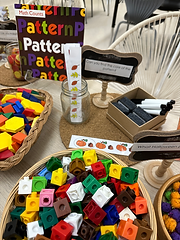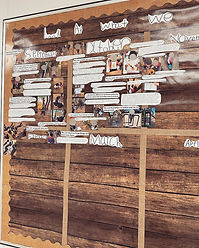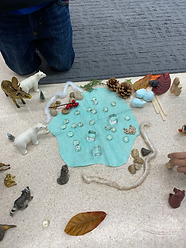
Play-Based Learning
What is Play?
“The definition of play is elusive. However, there is a growing consensus that it is an activity that is intrinsically motivated, entails active engagement and results in joyful discovery. Play is voluntary and often has no extrinsic goals; it is fun and often spontaneous.”- American Academy of Paediatrics, 2018 (Sahlberg & Doyle, 2019)
Early Childhood Education theorist, Friedrich Froebel defined play as “Play, then, is the highest expression of human development in childhood, for it alone is the free expression of what is in the child’s soul.” (Sahlberg & Doyle, 2019)
What is Play-Based Learning?
I define play-based learning as a pedagogical approach where children guide the learning through playful experiences. Through these playful experiences, children connect to curricular goals and build a natural, intrinsic motivation and curiosity to learn (Krogan, 2022).
Play and the Grade One Curriculum
“The paradigm shift that occurs between Kindergarten and Grade 1 is unrealistic and abrupt. If playing is pleasurable, engaging, and creates feelings of joy and passion in learning, it should become an integral and accepted practice beyond Kindergarten. Play should not be regulated to a “thing of the past,” recess, or strictly leisure activity.” (Kobylak & Kalyn, 2017)
With the release of the play-based Kindergarten curriculum, we as educators know play is important, and the importance of play doesn’t stop at 5 years old. So why does play stop being mentioned in the curriculum beyond Kindergarten? Since there is no mention of play in the Grade 1 curriculum, introducing play in your classroom can be a daunting, and at times challenging task when going against the norms of a more “traditional” Grade 1 approach. Although play is not mentioned in the Grade 1 curriculum, curricular outcomes can still be reached through play.
The demands and timelines of the Grade 1 curriculum can be challenging. Using playful approaches and hands-on learning such as invitations, provocations, Story Workshop, and outdoor learning can help bridge the gap for teachers, students, and their families.
Benefits of Play
“Everyone learns best through play. When you are relaxed and having fun you are more likely to remember, experiment, look deeply. I believe that all learning should be fun, engaging, and playful.”- Reesa Sorin (Sahlberg & Doyle, 2019)
“Anyone who fully understands child development knows that children’s “play” is children’s “work”-Gloria Landson-Billings (Sahlberg & Doyle, 2019)
-
Play:
-
Play reaches cross-curricular outcomes and increases family engagement in the Grade 1 classroom (Kobalyk & Kalyn, 2017)
-
Develops oral language
-
Builds social skills
-
Develops fine and gross motor skills
-
Invites children to share their views of the world around them
-
Encourages self-regulation
-
Engages students
-
Develops social and emotional skills
-
Improves turn-taking
-
Students are more intrinsically motivated to learn
-
Increases attention
-
Improves relationships (amongst teachers, students, and peers)
-
Invites students to extend their knowledge
-
Allows you to meet children where they are at
-
is universal and lessens the gap between varying languages
-
-
Benefits of play based on research from the National Museum of Play:
-
Physical- develops strong healthy bodies, improves gross motor, increases stress management, coordination, confidence, and agility.
-
Cognitive- improves scientific and mathematical thinking, encourages and improves research skills, inquiry, independent thinking, language and literacy skills,
-
Social- improves cooperation, negotiation, collaboration, socialization, rule formation, and conflict resolution.
-
Emotional- children experience joy, develop empathy, resilience, persistence, self-regulation, self confident, and impulse control (Sahlberg & Doyle, 2019).
-
Finding the Balance
Play-based pedagogy is “both philosophically and empirically supported.” (Deluca, Pyle, Valiquette, & Lapointe-Mcewan, 2020)
Finding the balance between instruction and play can be difficult. Although direct instruction is still important, purposeful play supports the development of the whole child to meet grade-level expectations (Horstmann, 2022). Children need both structured and unstructured play. While students are playing, inquiring, and exploring, teachers can pull small groups during play and provide the important direct instruction that is needed.
"Purposeful play ultimately allows access to learning that direct instruction may block when students are coming from backgrounds with low socioeconomic statuses and English Language needs” (Horstmann, 2022).
"Integrating play-based learning is how educators can begin to target not only the academic needs, but the social emotional ones that continue to be pushed to the side” (Horstmann, 2022).
Play can range from teacher-directed play to free play. If you are interested in learning about different types of play, including free play, inquiry play, collaboratively designed play, playful learning, and learning through games, check out this amazing website based on research from Dr. Angela Pyle (Deluca, Pyle, Valiquette, & Lapointe-Mcewan, 2020):
-
Incorporating Playful Learning in Your Grade 1 Classroom:
-
Playful activities: Story Workshop, invitations and provocations, outdoor learning, exploring, and inquiry, and STEM bins.
-
Story Workshop is a playful way to encourage students to create, tell, and write stories.
-
STEM bins is a fun and hands-on learning experience and great to use as a soft start to your days.
-
Begin with providing materials from a unit for children to explore, then develop essential questions with students and connect it to curricular outcomes (Kobalyk & Kalyn, 2017).
-
Since the curriculum is outcome based, indicators are flexible which grant teachers flexibility in how the outcomes are met, observed, and shown.
-
Be well planned, ask questions, observe, inquire, provoke, and provide meaningful resources and materials that reflect student interest, families, curriculum, and the environment to support meaningful learning during play.
-
Please check out the "Curriculum" tab to see many playful suggestions to reach curricular outcomes.
-
Observing and Assessing Play:
-
In 2017, I completed an inquiry on how curricular outcomes are reached through play in Kindergarten. Through this project I began to develop an understanding of play-based learning and how it reached curricular outcomes in the classroom and beyond. Understanding how easily play can reach curricular outcomes, I took this knowledge and began bringing it into the Grade 1 classroom.
- Tips for Observing and Assessing Play:
-
Teachers, administrators, and families may question how well curricular outcomes are reached through play and outdoor learning. It is important that the learning is well documented for this reason, as well as for your own records and assessment of learning. Documentation is important when faced with questions/challenges about student learning. It as well provides students and teachers with visuals of what they know and have learned.
-
Documentation is SO important. There are many ways documentation can be done. This can be shown in the classroom through monthly learning snapshots, digital learning portfolios, photos, videos, anecdotal records, recordings, conversations, poster/bulletin boards, student sample work, diagrams, posted outcomes, and "I can" statements, etc.
-
Make outcomes clear. Make sure you know exactly what you are looking for/assessing that day.
-
Share evidence of learning with families.
-
Provide feedback to children.
-
Individualize assessments for children.
-
Reflect on what you are seeing as an educator and what is being learned by the students and then decide what direct instruction is necessary. (Kobalyk & Kalyn, 2017)
-
Keep a checklist of students, so you know who has been observed and listened to.
-
Slow down and be present with your students.
-














